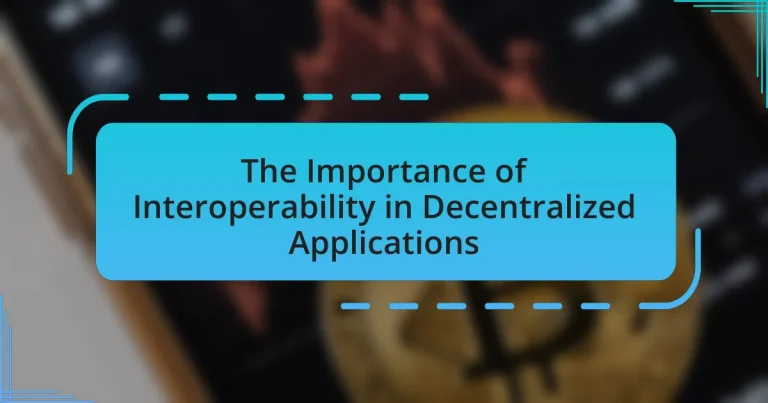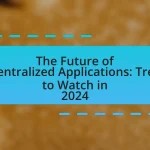Interoperability in decentralized applications is defined as the capability of various blockchain networks and decentralized systems to communicate and interact seamlessly. This article explores the significance of interoperability, highlighting its role in enhancing user experience, increasing liquidity, and fostering innovation within the decentralized ecosystem. It addresses the challenges posed by a lack of interoperability, such as data silos and increased operational costs, while detailing the key components and technologies that facilitate interoperability. Additionally, the article examines how interoperability impacts the development, scalability, and user adoption of decentralized applications, as well as future trends and best practices for developers to ensure effective integration across platforms.
What is Interoperability in Decentralized Applications?
Interoperability in decentralized applications refers to the ability of different blockchain networks and decentralized systems to communicate and interact with one another seamlessly. This capability allows users to transfer assets, share data, and execute smart contracts across various platforms without the need for intermediaries. The significance of interoperability is underscored by the fact that it enhances user experience, increases liquidity, and fosters innovation by enabling diverse decentralized applications to work together, thereby creating a more cohesive ecosystem.
Why is interoperability crucial for decentralized applications?
Interoperability is crucial for decentralized applications because it enables seamless communication and interaction between different blockchain networks and platforms. This connectivity allows users to transfer assets and data across various systems, enhancing the overall functionality and user experience of decentralized applications. For instance, the ability to execute cross-chain transactions can significantly increase liquidity and user engagement, as evidenced by the rise of decentralized finance (DeFi) protocols that rely on interoperability to facilitate trading and lending across multiple blockchains.
What challenges arise from a lack of interoperability?
A lack of interoperability leads to significant challenges such as data silos, increased operational costs, and limited user experience. Data silos occur when systems cannot communicate, preventing the seamless exchange of information, which hinders collaboration and innovation. Increased operational costs arise from the need for multiple systems to perform similar functions, leading to inefficiencies and resource wastage. Additionally, limited user experience results from fragmented services that do not integrate well, causing frustration and reducing overall satisfaction. These challenges underscore the critical need for interoperability in decentralized applications to enhance functionality and user engagement.
How does interoperability enhance user experience in decentralized applications?
Interoperability enhances user experience in decentralized applications by enabling seamless interaction between different platforms and services. This connectivity allows users to transfer assets, data, and functionalities across various decentralized networks without friction. For instance, when users can easily move tokens between Ethereum and Binance Smart Chain, it reduces the complexity and time involved in transactions, leading to a more efficient and satisfying experience. Furthermore, interoperability fosters a broader ecosystem where users can access diverse services and applications, increasing engagement and utility. Studies have shown that platforms with higher interoperability tend to attract more users, as they provide greater flexibility and options, ultimately enhancing overall satisfaction.
What are the key components of interoperability in decentralized applications?
The key components of interoperability in decentralized applications include standardized protocols, cross-chain communication, and shared data formats. Standardized protocols enable different decentralized applications to communicate effectively, ensuring compatibility and seamless interaction. Cross-chain communication facilitates the transfer of assets and information between various blockchain networks, enhancing the functionality of decentralized applications. Shared data formats allow for consistent data representation across different platforms, which is crucial for maintaining integrity and usability in a decentralized ecosystem. These components collectively contribute to a more interconnected and efficient decentralized application landscape.
What technologies facilitate interoperability?
Technologies that facilitate interoperability include APIs, blockchain protocols, and standardized data formats. APIs enable different software systems to communicate and exchange data seamlessly, while blockchain protocols, such as Ethereum and Hyperledger, allow for secure and transparent transactions across various platforms. Standardized data formats, like JSON and XML, ensure that data can be easily shared and understood between different systems. These technologies collectively enhance the ability of decentralized applications to work together effectively, promoting a more integrated ecosystem.
How do protocols play a role in achieving interoperability?
Protocols are essential for achieving interoperability as they establish standardized rules and conventions that enable different systems to communicate effectively. By defining how data is formatted, transmitted, and processed, protocols ensure that diverse applications can exchange information seamlessly. For instance, the use of HTTP and TCP/IP protocols allows web browsers and servers to interact, facilitating the functioning of decentralized applications across various platforms. This standardization reduces compatibility issues and enhances the ability of systems to work together, which is crucial for the success of decentralized ecosystems.
How does interoperability impact the development of decentralized applications?
Interoperability significantly enhances the development of decentralized applications by enabling seamless communication and data exchange between different blockchain networks. This capability allows developers to create applications that leverage the strengths of multiple platforms, thereby increasing functionality and user engagement. For instance, projects like Polkadot and Cosmos facilitate interoperability, allowing decentralized applications to operate across various blockchains, which can lead to improved scalability and reduced transaction costs. Furthermore, interoperability fosters innovation by allowing developers to integrate diverse features and services, ultimately contributing to a more robust decentralized ecosystem.
What benefits does interoperability provide to developers?
Interoperability provides developers with enhanced flexibility and efficiency in creating decentralized applications. By enabling different systems and platforms to communicate and work together seamlessly, developers can leverage existing technologies and services, reducing the need to build everything from scratch. This capability fosters innovation, as developers can integrate diverse functionalities and data sources, leading to more robust applications. Furthermore, interoperability can improve user experience by allowing users to interact with multiple services without friction, thereby increasing user engagement and satisfaction.
How does interoperability reduce development time and costs?
Interoperability reduces development time and costs by enabling seamless integration between different systems and platforms, which minimizes the need for custom coding and extensive modifications. When decentralized applications can communicate and share data across various networks, developers can leverage existing functionalities rather than building everything from scratch. This efficiency is supported by studies indicating that projects with high interoperability can reduce development cycles by up to 30%, as they avoid redundant work and streamline processes. Additionally, interoperability fosters collaboration among teams, allowing for shared resources and knowledge, further driving down costs associated with development.
What are the implications of interoperability for application scalability?
Interoperability significantly enhances application scalability by enabling seamless communication and data exchange between diverse systems and platforms. This capability allows applications to leverage external resources, services, and functionalities, thereby facilitating the integration of additional features without extensive reconfiguration. For instance, decentralized applications that can interact with multiple blockchain networks can scale their operations by accessing a broader user base and utilizing various protocols, which increases overall efficiency and reduces bottlenecks. Furthermore, studies indicate that systems designed with interoperability in mind can handle increased loads more effectively, as they can distribute tasks across multiple platforms, thus optimizing performance and resource utilization.
How does interoperability influence user adoption of decentralized applications?
Interoperability significantly enhances user adoption of decentralized applications by enabling seamless interaction across different platforms and networks. When decentralized applications can communicate and share data with one another, users experience greater convenience and functionality, which encourages them to engage with multiple applications. For instance, a study by the World Economic Forum highlights that interoperability can reduce friction in user experiences, leading to a 30% increase in user engagement in decentralized finance platforms. This interconnectedness not only fosters a more robust ecosystem but also builds user trust, as individuals are more likely to adopt applications that integrate well with their existing tools and services.
What role does interoperability play in enhancing security for users?
Interoperability enhances security for users by enabling seamless communication and data exchange between different systems and platforms. This interconnectedness reduces vulnerabilities, as it allows for the implementation of standardized security protocols across various applications, making it easier to identify and mitigate threats. For instance, when decentralized applications can interact with one another, they can share threat intelligence and security updates in real-time, which strengthens the overall security posture. Additionally, interoperability fosters a collaborative environment where security measures can be uniformly applied, thus minimizing the risk of isolated breaches that could exploit weaknesses in a single application.
How can interoperability foster a larger user base for decentralized applications?
Interoperability can foster a larger user base for decentralized applications by enabling seamless interaction between different platforms and networks. This connectivity allows users to access a broader range of services and functionalities without being restricted to a single ecosystem, thereby enhancing user experience and attracting more participants. For instance, when decentralized applications can communicate and share data across various blockchains, users benefit from increased flexibility and choice, which can lead to higher adoption rates. Studies have shown that platforms with interoperability features tend to experience greater user engagement and retention, as they provide a more comprehensive and integrated experience.
What are the future trends in interoperability for decentralized applications?
Future trends in interoperability for decentralized applications include the development of cross-chain protocols, enhanced standards for communication between different blockchain networks, and the integration of decentralized identity solutions. Cross-chain protocols, such as Polkadot and Cosmos, facilitate seamless interactions between various blockchains, allowing assets and data to move freely across platforms. Enhanced standards, like the Interledger Protocol, aim to standardize communication methods, improving compatibility and reducing friction. Additionally, decentralized identity solutions are gaining traction, enabling users to manage their identities across multiple applications securely, fostering a more interconnected ecosystem. These trends are supported by the increasing demand for user-friendly decentralized applications that require efficient interoperability to enhance user experience and functionality.
How are emerging technologies shaping interoperability?
Emerging technologies are significantly shaping interoperability by enabling seamless communication and data exchange across diverse systems. Technologies such as blockchain, artificial intelligence, and the Internet of Things (IoT) facilitate standardized protocols and frameworks that enhance compatibility among decentralized applications. For instance, blockchain technology allows for secure and transparent transactions across different platforms, while AI algorithms can optimize data integration processes, ensuring that disparate systems can work together efficiently. The integration of these technologies is evidenced by the increasing adoption of cross-chain solutions, which allow different blockchain networks to interact, thereby improving overall system interoperability.
What potential does blockchain have for improving interoperability?
Blockchain has significant potential for improving interoperability by enabling seamless data exchange and communication between different systems and networks. This potential arises from blockchain’s decentralized nature, which allows multiple parties to access and verify shared data without relying on a central authority. For instance, projects like Polkadot and Cosmos utilize blockchain technology to create frameworks that facilitate interoperability among various blockchains, allowing them to share information and assets efficiently. Additionally, the use of standardized protocols, such as the Interledger Protocol, further enhances interoperability by providing a common language for different blockchain networks to interact. These advancements demonstrate that blockchain can effectively bridge gaps between disparate systems, fostering a more interconnected ecosystem.
How might artificial intelligence contribute to interoperability solutions?
Artificial intelligence can enhance interoperability solutions by enabling seamless communication and data exchange between diverse systems. AI algorithms can analyze and interpret data formats, protocols, and standards, facilitating integration across platforms. For instance, natural language processing can help translate and standardize terminologies used in different applications, while machine learning can identify patterns and optimize data flows, improving system compatibility. These capabilities are crucial in decentralized applications, where multiple entities must interact efficiently, ensuring that data integrity and user experience are maintained.
What best practices should developers follow to ensure interoperability?
Developers should follow several best practices to ensure interoperability in decentralized applications. First, they should adopt open standards and protocols, such as RESTful APIs or GraphQL, which facilitate communication between different systems. Utilizing widely accepted data formats like JSON or XML enhances compatibility across platforms. Additionally, developers should implement modular architecture, allowing components to interact seamlessly regardless of the underlying technology.
Testing for interoperability during the development process is crucial; this includes using automated testing tools to verify that different systems can communicate effectively. Furthermore, thorough documentation of APIs and data structures aids other developers in understanding how to integrate with the application.
Finally, engaging with the developer community and participating in open-source projects can provide insights into best practices and emerging standards, fostering a collaborative environment that enhances interoperability. These practices are supported by industry trends emphasizing the need for compatibility in a rapidly evolving technological landscape.
How can developers effectively test for interoperability in their applications?
Developers can effectively test for interoperability in their applications by implementing a combination of automated testing frameworks, integration testing, and real-world scenario simulations. Automated testing frameworks, such as Selenium or Postman, allow developers to create scripts that validate the interaction between different components and services, ensuring that data flows correctly across systems. Integration testing focuses on the interaction between various modules or services, confirming that they work together as intended. Real-world scenario simulations involve testing the application in environments that mimic actual user interactions and external systems, which helps identify potential interoperability issues that may not surface in isolated testing. These methods collectively ensure that applications can communicate and function seamlessly across different platforms and technologies.
What resources are available for developers to enhance interoperability?
Developers can enhance interoperability through various resources such as APIs, SDKs, and open-source libraries. These tools facilitate communication between different systems and platforms, allowing for seamless integration. For instance, the Ethereum blockchain provides APIs that enable developers to interact with smart contracts, while libraries like Web3.js simplify the process of connecting decentralized applications to the Ethereum network. Additionally, standards such as REST and GraphQL promote consistent data exchange, further supporting interoperability across diverse applications.





